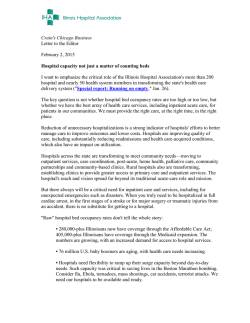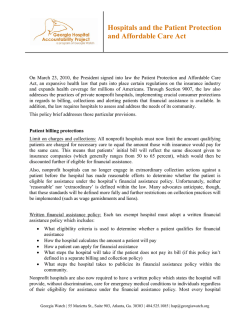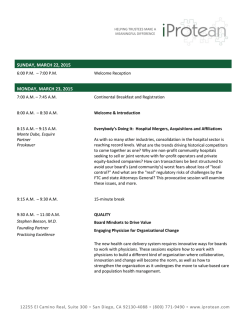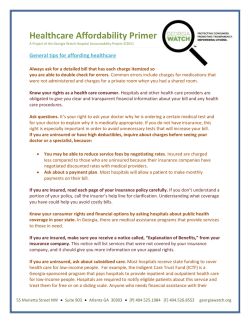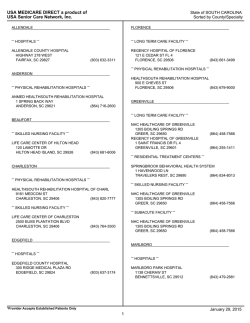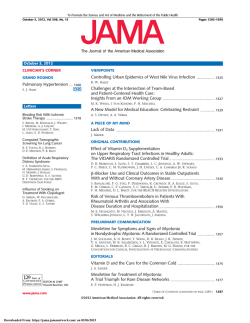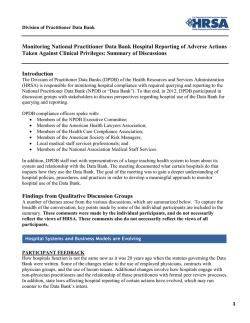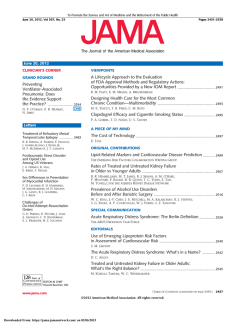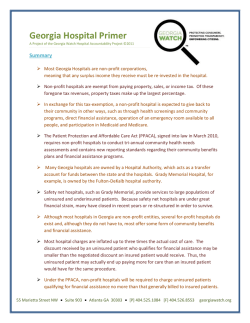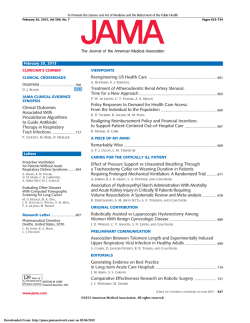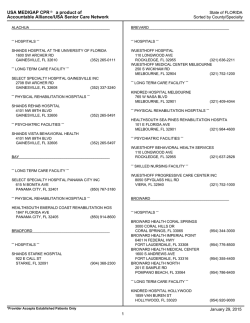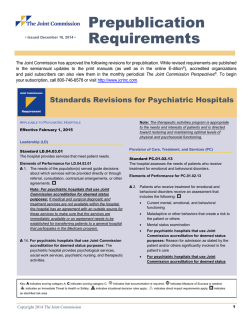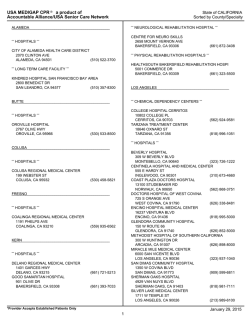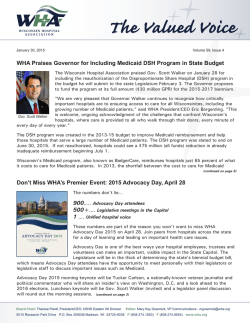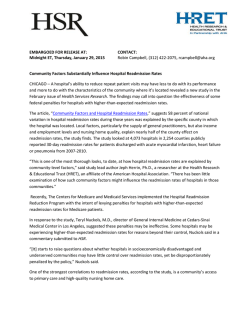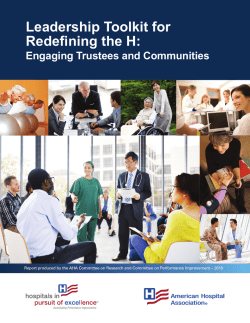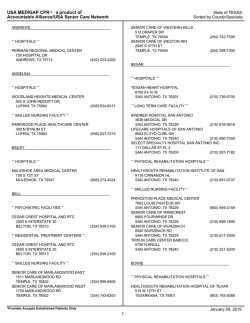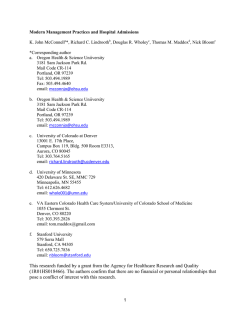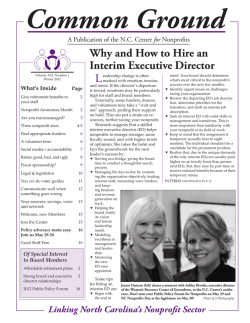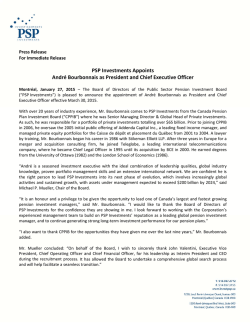
Hospital Community Benefit Programs Increasing Benefits to
Opinion VIEWPOINT Janet Corrigan, PhD, MBA Dartmouth Institute for Health Policy and Clinical Practice, Lebanon, New Hampshire. Elliott Fisher, MD, MPH Dartmouth Institute for Health Policy and Clinical Practice, Lebanon, New Hampshire. Scott Heiser, MPH Dartmouth Institute for Health Policy and Clinical Practice, Lebanon, New Hampshire. Corresponding Author: Janet Corrigan, PhD, MBA, Dartmouth Institute for Health Policy and Clinical Practice, 35 Centerra Pkwy, Ste 100, HB7251, Lebanon, NH 03766 (janet.m.corrigan @dartmouth.edu). Hospital Community Benefit Programs Increasing Benefits to Communities Promising health care delivery and payment reforms are under way that may have contributed to the slower rates of growth in health care spending seen in recent years. Delivery reform alone, however, is unlikely to slow cost growth over the long run: it is important to address the social, economic, and environmental determinants that contribute to the increasing burden of poor health and chronic illness. Other industrialized countries that achieve better population health pursue more balanced investment strategies that recognize the contributions of the full set of health determinants.1 Building on these insights, multistakeholder initiatives have been established in many US regions to coordinate multisector investments and activities focused on improving population health. Whether these will succeed locally or spread sufficiently across the country remains far from certain.2 In this Viewpoint, we suggest that a modest reorientation of hospital community benefit programs could help accelerate the development of successful regional health improvement initiatives. The geographic communities in which people live and work have a profound effect on their health and the health care they receive. With strong support from national and local foundations, the Federal Reserve Bank, the Centers for Disease Control and Prevention, and others, a grassroots, community-level movement focused on establishing multisector, multistakeholder organizations to coordinate health-related initiatives has been increasing steadily for more than a decade.1 Recognizing the need for organizations focused on coordinating healthrelated activities at the regional level (between local delivery systems and state-level interventions), more than half of the 17 states with Center for Medicare and Medicaid Innovation (CMMI) grants to implement and test state innovations model plans are establishing regional collaborative structures, sometimes called accountable health communities (AHCs).3 The CMMI has appointed a team to consider how AHCs could be fostered more widely and to explore financial models that could provide balanced and sustainable funding for health and health-related social services. Many of these regional initiatives pursue what is known as a collective impact strategy characterized by 5 elements: (1) a coordinating (ie, backbone) organization that mobilizes diverse cross-sector leadership to (2) set a common agenda and (3) pursue mutually reinforcing activities supported by (4) continuous communication to build trust and relationships and (5) shared measurement systems.4 Hospital community benefit programs could provide both leverage and resources to increase the effect of regional initiatives. The provision of community benefits has been an obligation of tax-exempt hospitals for jama.com many decades. Estimated community benefit contributions for 2012 totaled nearly $37 billion (7.5% of nonprofit hospitals’ operating expenses), for a national average expenditure of $119 per capita.5 State per capita contribution levels, correlated with the proportion of nonprofit hospitals, varied greatly, from $30 in Alabama to $335 in Vermont. To date, the majority of community benefit contributions have been devoted to services directly related to patient care (eg, charity care, unreimbursed costs under Medicaid and the Children’s Health Insurance Program), but this may be changing. Recent estimates from the Department of Health and Human Services (HHS) are that uncompensated care provided by hospitals will decline by $5.7 billion in 2014 to an expected level of around $28 billion.6 If a portion of community benefit contributions were redirected toward high-leverage community health improvement initiatives, it could represent a commitment of the estimated $90 billion needed for critical community supports to help vulnerable children and families7 and build community capacity to leverage other potential sources of funding.8 The current legal and regulatory structures, shaped by IRS tax code, a patchwork of state laws, and more recently the Affordable Care Act (ACA), provide hospitals a substantial amount of flexibility while requiring little accountability or evidence of effect on population health. Although the ACA established requirements that hospitals conduct community health needs assessments and develop community health improvement plans with input from community leaders, it stopped short of embracing a major shift from an individual hospital community benefit model to a collaborative regional approach.1 In most communities, each hospital independently operates its own community benefit program, largely focusing on its immediate service area. This risks widening health disparities as suburban hospitals focus on their relatively well-off neighborhoods, whereas urban hospitals (faced with greater burdens of uncompensated care) are likely to have more limited resources to invest in community initiatives. Four principles could help guide the development of a strategy for leveraging community benefit programs to increase their influence: defining mutually agreed-on regional geographic boundaries to align both community benefit and AHC initiatives, ensuring that community benefit activities use evidence to prioritize interventions, increasing the scale and effectiveness of community benefit investments by pooling some resources, and establishing shared measurement and accountability for regional population health improvement (Table). Atthefederallevel,communitybenefitlawsandregulations should be reviewed to remove barriers to regional coordination, allay hospitals’ concerns (actual or (Reprinted) JAMA Published online February 2, 2015 Copyright 2015 American Medical Association. All rights reserved. Downloaded From: http://jama.jamanetwork.com/ on 02/06/2015 E1 Opinion Viewpoint Table. Potential Strategy for Leveraging Community Benefit Investments to Build Accountable Health Communities Goal Regional alignment and coordination Maximize effectiveness Increase leverage Ensure accountability Principle Hospitals should establish region-wide programs where possible and collaborate with other organizations, such as public health agencies or multistakeholder backbone organizations, to develop a region-wide community health needs assessment and shared community health improvement plan. Hospitals should develop a portfolio of evidence-based projects intended to produce the greatest overall return in terms of improved population health. Hospitals should consider or be required to pool some of their community benefit funds for investment by regional backbone organizations. Hospitals should measure, evaluate, and report the effectiveness of their community benefit investment portfolios. Rationale Broader community input. More equitable distribution of community benefit resources. Targeting of community benefit programs to neighborhoods with greatest need. Economies of scale. Example Western North Carolina Healthy Impact, a collaboration of 16 counties and as many hospitals, works together locally and regionally on community health improvement. Greater likelihood of benefit. Greater return on investment. Atlanta Regional Collaborative for Health Improvement identifies priorities for community health improvement and evidence-based program and policy interventions. Los Angeles requires all hospitals to contribute 1% of operating revenues to a wellness trust focused on prevention. Potential to tackle larger issues than individual hospitals could address. Commitment of hospitals may help leverage other sources of funding. Greater likelihood of sustained and meaningful effect on population health. Dignity Health has a community health index that tracks by zip code barriers that affect health, such as income, education, and housing. Sources: http://www.wnchealthyimpact.com/, http://www.archicollaborative.org/resources.html, http://www.forbes.com/sites/robwaters/2013/12/12/in-south -los-angeles-a-bold-plan-to-address-health-disparities/, http://www.dignityhealth.org. perceived)aboutantitrustviolations,andcreateincentivesorrequirements for regional alignment and collaboration. Of particular importance, ambiguity about the extent to which “community building” investments (eg, housing, economic development, coalition building) qualify as community benefits has led to calls for the IRS to establish “safe harbors” for certain types of investments strongly supported by evidence of benefit on health.9 As a part of any future CMMI demonstration projects focused on AHCs, the hospitals in a region should be encouraged to pursue a region-wide collaborative approach to community needs assessment and investment. It will also be important for HHS and the National Quality Forum to continue evolving and promoting the use of community-level, standardized measures that can be used to gauge progress within and across regions in addressing social and economic determinants and improving the health of various subpopulations. There may also be opportunities for states to promote a regionally focused community benefit model. Twenty-three states have community benefit requirements applicable to nonprofit hospitals, which may be unconditional or tied to property or sales tax exemptions, certification of need approval, hospital licensure, or partial reimbursement for charity care.10 States may want to be proactive in specifying geographic boundaries that align with state public health ARTICLE INFORMATION Published Online: February 2, 2015. doi:10.1001/jama.2015.0609. Conflict of Interest Disclosures: All authors have completed and submitted the ICMJE Form for Disclosure of Potential Conflicts of Interest and none were reported. REFERENCES 1. Financing population health improvement: workshop summary. https://www.iom.edu/Reports /2014/Financing-Population-Health-Improvement .aspx. Accessed January 27, 2015. 2. Berwick DM. Reshaping US health care. JAMA. 2014;312(20):2099-2100. E2 programs, AHC programs, or other regional initiatives and in incentivizing greater community benefit investments in the social determinants of health. Also, states with considerable for-profit hospital penetration, and consequently lower per capita community benefit expenditures, may want to consider allocating a portion of tax revenues from for-profit institutions to regional wellness trusts to ensure that there are adequate investments in community health. Although there are many advantages of shifting to a regionally focused community benefit model, there are also potential pitfalls. Some communities lack backbone organizations; others have multiple, competing organizations. Caution should be exercised to avoid developing new, costly structures where existing organizations may be able to assume roles in regional community benefit programs. The many backbone organizations that do exist vary greatly in terms of scope of responsibilities, capabilities, and track records. A thoughtful transition process and strong accountability system will be important. Standards and oversight will be needed to ensure that backbone organizations represent the interests of their community and make wise investment decisions. Transparency of governance will build legitimacy, as will periodic external evaluations of the investment decision-making process and the return on investment in terms of improved health and well-being. 3. State innovation models initiative. http: //innovation.cms.gov/initiatives/State-Innovations -Model-Testing-Round-Two/index.html. Accessed December 26, 2014. 7. Andrews N. How much do healthy communities cost? http://www.iom.edu/Global/Perspectives /2014/HealthCostCommentary.aspx. Accessed January 27, 2015. 4. How public policy can support collective impact. http://collectiveimpactforum.org/resources/how -public-policy-can-support-collective-impact. Accessed January 27, 2015. 8. Fisher ES, Corrigan J. Accountable health communities. JAMA. 2014;312(20):2093-2094. 5. Bakken E, Kindig D. Does nonprofit hospital community benefit vary by state? J Public Health Manag Pract. 2015;21(1):18-22. 6. DeLeire T, Joynt K, McDonald R. Impact of insurance expansion on hospitals uncompensated care costs in 2014. http://aspe.hhs.gov/health /reports/2014/UncompensatedCare/ib _UncompensatedCare.pdf. Accessed January 27, 2015. 9. Rosenbaum S, Rieke A, Byrnes M. Encouraging nonprofit hospitals to invest in community building. http://healthaffairs.org/blog/2014/02/11 /encouraging-nonprofit-hospitals-to-invest-in -community-building-the-role-of-irs-safe-harbors/. Accessed January 27, 2015. 10. Somerville MH, Nelson GD, Mueller CH. Hospital community benefits after the ACA. http: //www.hilltopinstitute.org/publications /HospitalCommunityBenefitsAfterTheACA -StateLawLandscapeIssueBrief6-March2013.pdf. Accessed January 27, 2015. JAMA Published online February 2, 2015 (Reprinted) Copyright 2015 American Medical Association. All rights reserved. Downloaded From: http://jama.jamanetwork.com/ on 02/06/2015 jama.com
© Copyright 2025
